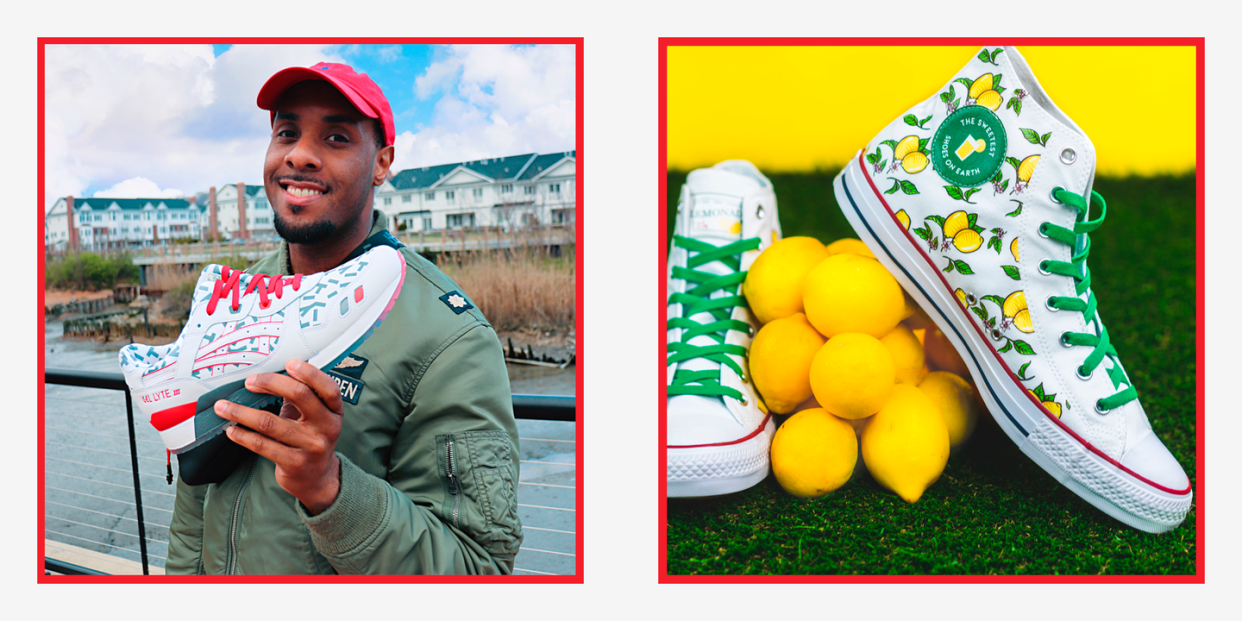How a Self-Taught Black Graphic Designer Became a Major Sneaker Designer

In a year defined by uncertainty and the global fashion industry going through its own major changes, sneaker collaborations remain one of the few reliable constants, with so new many releases happening on a rolling basis that it’s hard to keep up. And sometimes, these new collaborations feature the work of unexpected, talented artists, like Anderson Bluu who’s partnered with Foot Locker on its newest sneakers-for-a-cause initiative.
Anderson Bluu is a self-taught graphic designer and illustrator whose graphic prints combine elements of basketball, sneakers, and pop culture. After collaborating with a number of brands—his partnership with Asics last year was one of its most successful ever—the Long Island-based artist teamed up with Foot Locker for his most personal collection yet.
The collaboration is the latest installment in the retailer’s ongoing Collaboraid Collection which features a range of new shoe designs from popular artists and designers. Others that have partnered with the brand include A$AP Ferg, Chinatown Market, PJ Tucker, and Sophia Chang. Each release is a response to the ongoing coronavirus pandemic and will benefit youth in regions most affected.
The new Lemonade sneaker, which launches today, is inspired by Anderson’s childhood summers in Long Island. “Lemonade pays homage to my childhood summers: the family BBQs, endless cookouts, and homemade lemonade,” he said in a statement. “These sneakers are inspired by youthful summer days and designed to remember the many lemonade stands I built to fund my love for sneakers.”
A post shared by Anderson Bluu (@anderson_bluu) on Sep 10, 2020 at 1:19pm PDT
The design is pretty literal in referencing its inspiration. For the collaboration, Anderson updated the classic Converse All Star shoe with an all-over cartoon lemon print and a patch that reads “The Sweetest Shoes on Earth.” Each shoe is even wrapped in a mesh fruit bag to really drive the theme home. Less than 200 pairs will be produced and sold on Foot Locker’s website, adding an element of exclusivity and a novelty appeal that will no doubt increase over time.
“When it came to the opportunity, I saw it as a great time to tap back to my childhood when I was trying to make money for sneakers,” he says. “Now I’m actually a designer that’s able to make sneakers based on my childhood.” It’s a true full-circle moment for the designer, who started a clothing business almost a decade ago before a sports injury—he tore his patellar tendon, aka “the thing that keeps your knee in place,”—inspired him to fully commit to pursuing graphic design. His sneaker-inspired work was quickly noticed by Hypebeast, which shared it on Instagram, and soon his own following started to grow. But the rapid success from self-taught hobby to large following was fairly unprecedented. “[Once] I saw there was interest and I said, ‘You know what, I’ll do it for a year and see what happens.’ That’s how everything started.”
A post shared by Anderson Bluu (@anderson_bluu) on Aug 5, 2020 at 9:48am PDT
It wasn’t long before the very sneaker brands he looked up for started asking about collaborating.
In the last few years, sneakers and the larger streetwear scene have exploded into the mainstream and beyond. Major designers like Louis Vuitton and Dior Men have released their own line of sneakers, often having partnered with emerging artists to incorporate authentic points of view into their work. After witnessing this trend evolution over the last few years, Anderson has come to terms with sneaker culture’s newfound popularity, moving beyond the fringe into the heart of the mainstream.
“At first, I was bummed about it,” he confesses. “But after seeing how the younger audience is navigating it, I think it’s a good thing.” He elaborates by explaining how there used to be an element of exclusivity to those in the scene—you either got it or you didn’t. But the expanded amount of resources for younger generations to learn about and get involved with the culture has led to more opportunities for those looking to enter the business.
His work continues to be a reflection of the media that influenced him during his childhood—he cites Looney Tunes and Disney as two major factors that continue to inform his graphic style. There’s a playful and nostalgic element in his work that’s refreshing to see today. Anderson feels it’s his responsibility to give his audience “a sense of normalcy.”
To go from being a sneakerhead, and selling lemonade to support your habit, to designing a limited-edition collection of sneakers is a dream. And for an industry that doesn’t have a specific business model to follow, he is a true success story. “Anybody who loves sneakers, they would love to design but unless you work for one of the bigger companies, it almost feels like it’s impossible to make that happen,” he says. “That was one of the biggest hurdles for me; just trying to figure out how to take it from zero to being looked at as a renowned artist.”
A post shared by Anderson Bluu (@anderson_bluu) on Jul 3, 2020 at 3:42pm PDT
This newfound platform isn’t lost on Anderson—he recognizes his place in the culture and his position as a Black artist navigating a competitive industry. “There’s not many Black artists, period. I think that connects with the kids, also. And I think it’s important for people to see different demographics.” His journey hasn’t been conventional or easy by any means. But the build-up just makes Anderson’s deserved success all the sweeter.
“This stuff didn’t happen overnight—this has been 12 years of just figuring it out,” he says. “I’m just happy to be able to work with some of the best in the game and, especially now, to do it for a good cause.”
You Might Also Like

